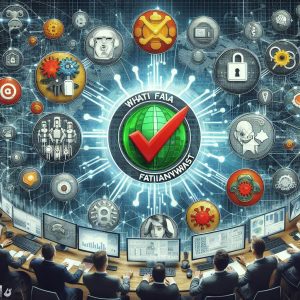What is Fake Antivirus Software
Fake antivirus software, also known as rogue security software or scareware, is a form of malware that pretends to be legitimate antivirus software. It deceives users into believing their computer is infected with viruses or other malware, then suggests they download and install the fake antivirus program to remove the threats.
Instead of detecting real viruses, the main motive behind fake antivirus is to extort money from victims and/or install additional malware that steals personal and financial information. Fake antivirus has been one of the most prevalent and persistent malware threats over the past decade.
How Fake Antivirus Software Works
Fake antivirus leverages social engineering techniques to manipulate users through fear and urgency. It typically infiltrates a computer system through malicious ads, search engine links or infected files from questionable websites. Once installed, it generates alarming security warnings resembling authentic antivirus alerts about supposed malware or privacy threats.
To eliminate the “infections”, fake antivirus directs users to purchase the full rogue security software or install additional bogus privacy tools riddled with actual malware. Some versions automatically download at this stage without any user action. The added malware then steals sensitive data like login credentials and credit card numbers or encrypts files for ransom.
Meanwhile, the fake antivirus program displays countdown timers, fake security scans and other deceptive notifications to pressure victims into immediate action. Legitimate antivirus brands like Norton, McAfee and AVG are often impersonated both visually and by name to further dupe users. Without intervention, rogue security software becomes exceedingly difficult to remove as it blocks access to other programs and security websites.

Examples of Fake Antivirus Software
Some of the more widespread fake antivirus families over the past decade include:
Fake AVG Antivirus – Cybercriminals distributed millions of malware samples masked as AVG Antivirus throughout Europe and North America. Fake infection warnings popped up resembling authentic AVG alerts, directing users to call fraudulent support numbers for supposed assistance removing malware.
Windows Police Pro – This fake antivirus variant pretends to be legitimate Windows security software called Windows Police Pro. When launched, it displays fake malware scan results showing hundreds of privacy and security threats. To eliminate the bogus threats, it prompts for credit card payment to activate the “full version”.
MacKeeper – Advertised as a performance optimization and security tool for Mac OS, multiple versions of MacKeeper employed scare tactics about malware and privacy vulnerabilities. After showing fabricated scan results, victims were deceived into paying over $40 for the fake software while actual malware installed covertly.
These examples demonstrate how fake antivirus historically infiltrated all major computing platforms by impersonating trusted security brands. Cybercriminals continue creating new variants at pace with contemporary antivirus solutions and operating systems.
How to Spot Fake Antivirus Software
Since rogue security software utilizes social engineering to manipulate emotions, even tech-savvy users can be deceived. But applying critical thought around software behaviors, notifications and money requests reveals telltale signs of fake antivirus. Warning flags include:
- Unexpected security alerts about malware threats or compromised privacy after visiting benign websites
- Fake antivirus using names, logos or terminology mimicking leading security brands
- Alarming language and imagery provoking fear or urgency around supposed infections
- Fake scanning results showing malware threats, even when running reputable antivirus software
- Repeated popups pressuring immediate software purchases or actions to remove supposed malware
- Rogue antivirus blocking access to other websites and security-related programs
- Credit card charges or paid subscriptions required to eliminate fabricated malware alerts
Seeing one or more of these behaviors indicates high probability of fake antivirus infection. The software triggers false positives to trick users, not accurately detect real malware. Users should avoid interacting with the program or calling its advertised support numbers for assistance.

Protecting Yourself from Fake Antivirus Attacks
Defending against rogue security software requires awareness around online safety practices and proactive security configurations:
- Maintain updated antivirus protection from trustworthy vendors like Bitdefender, Kaspersky or Malwarebytes. They can block initial fake antivirus infiltration attempts.
- Beware search engine ads, popups and unsolicited links offering software optimizing your computer’s speed or security, even from supposed well-known brands. These commonly distribute fake antivirus.
- If you see any suspicious security alerts inside your web browser or on your desktop, do not click on anything or call the number listed. Fake notifications often launch or install rogue antivirus through user interaction. Check your actual antivirus program or credible online sources to confirm infections.
- Disable browser plugins like Adobe Flash whenever possible and avoid downloading random software to reduce attack surface. Fake antivirus often leverages plugins and bundled software installers as infection vectors.
- Reform risky online habits around accessing questionable websites, pirated software and explicit content, as these channels frequently spread rogue security software through malicious ads and downloads.
Properly configuring Windows, Mac or Linux devices also reduces fake antivirus risks:
- Update operating systems and software frequently to patch security flaws leveraged to covertly install fake antivirus.
- Enable firewalls and activate OS security protections like Windows Defender or Gatekeeper on Mac.
- Only provide applications admin rights when absolutely necessary. Fake antivirus abuse elevated privileges to infect systems.
- Setup ad blocking and script/popup blocking extensions in web browsers. Fake antivirus commonly deploys through malicious browser ads.
Carefully vetting software installs, avoiding suspicious links and employing trustworthy antivirus solutions significantly lowers chances of encountering fake security tools. But proper precautions remain essential given how aggressively rogue software continues evolving new social engineering and distribution tactics.
Removing Fake Antivirus Infections
Despite preventative efforts, some fake antivirus infections still occur. Rogue security software intentionally makes manual removal challenging by blocking other programs and security sites. However, several proven methods exist:
Opt 1: Use legitimate antivirus tools like those from Malwarebytes, Bitdefender and Kaspersky. Their remediation tools locate and automatically remove over 95% of new fake antivirus strains. Ensure continuous access to latest malware definitions for handling latest rogue variants.
Opt 2: Boot computer in Safe Mode before running scans. Windows Safe Mode launches the OS with limited functionality and disables most other software. This prevents fake antivirus interference, allowing reputable tools to remove infections under isolated conditions.
Opt 3: Reset web browser settings since fake software often modifies them to revert cleaning changes or re-launch infections. Be sure to uninstall all unwanted browser add-ons previously installed by the fake antivirus as well.
For severe infections unresolved using the above actions, the nuclear option involves completely wiping the OS drive and reinstalling Windows, Mac OS or Linux from scratch. This eliminates all residual rogue antivirus software left embedded in the system. Be aware that this also erases all other user data, making pre-wipe backups critical.
If existing data prevents reformatting entire systems, seek professional IT assistance for removing stubborn fake antivirus instances. Tech repair specialists have commercial-grade tools and knowledge to clean even advanced infections without data loss.

Conclusion
For over a decade, fake antivirus software has remain a predominant cyber threat through constantly evolving social engineering and malware tactics. It represents a prime example of just how effectively malicious actors manipulate human emotions like fear to override logical reasoning.
As with most sophisticated cyber scams, precaution remains the most potent defense against rogue security tools. Maintaining diligent software habits, using reputable antivirus suites and enabling security protections makes infection exponentially less likely. But the persistent ingenuity of cybercriminals means even savvy users must remain constantly vigilant against fake antivirus and its shifting distribution strategies.